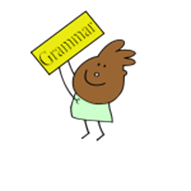15 Grammar Mistakes You’re Probably Making
Here is a fantastic graphic you can use as a printout or poster in your classroom. This graphic illustrates the difference between words that are commonly misused and includes both pictures and definitions for each word. This graphic was originally created by “copyblogger” and the original source plus other content by “copyblogger” can be be found here.

Parts of Speech Flipbook
This tool created by “Layers of Learning” helps students learn the different parts of speech. Under each tab is a definition of the element along with a few examples the students were able to come up with in class. as students learn more about this elements in class, they add more examples to their flipbook. This tool can then remind students what they already have learned and support them throughout the unit. By the end of the unit (or school year), the students have a detailed and useful tool they can use. In their article “Layers of Learning” describes how they made and used this tool in class, provide a graphic that can serve as a companion to the flipbook, and provides other activities you can use to teach students about the parts of speech.The original article can be found here.
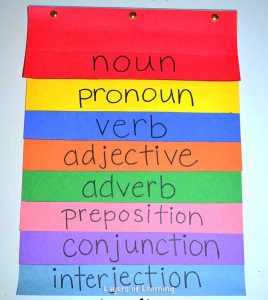
Want to Kick it Up a Notch?
This is probably one of my favorite tools I have found because it can be adapted and integrated in so many ways! There are a couple of ways you can improve upon the example “Layers of Learning” provides as well as other ways you can use this tool for other purposes. One way to improve on this example is to use different colors for the definition and the examples. As I looked through the examples, I often had to search for the definition. It never took me too long to find it, but this task would have become harder the more examples I added. Additionally, where the teacher’s example is very organized and the definition is often in the same place, younger students may not demonstrate the same organizational skills, causing further confusion. Using a different color or other designation for the definition will help the definition stand out and will allow students to use this tool more efficiently and effectively.
Another way to improve on this sample would be to include simple images that students can associate with that element of speech. If you go to the original post, you can see “Layers of Learning” example for “preposition” and that it includes a thought bubble. Since people are able to process images much faster than words, I like the idea of expanding this use of a basic image that represents each element being incorporated on each tab. Students can even draw a smaller version of the symbol next to the element name to further solidify the association.
Finally, this tool is extremely versatile. “Layers of Learning” used poster-size paper for the project, so these tools are pretty big. However, they can easily be shrunk down and can even be placed inside writing/reading journals students are using for easy access. The flipbook concept can easily be adapted to a wide variety of topics and grade levels as well. If I wanted to use the this project for highschool students, I may use it as a form of organizer for a paper or as a way to keep track of characters in a class novel. My flipbook could also be used for notes on the Elements of Culture in Social Studies or different algorithms in Math. The possibilities are endless!
Roll-A-Story
“MsJordanReads” has created a fun way to build a story using dice. Students start by rolling the dice and finding the corresponding character in the first column. They then repeat this step two more times to find a setting (column two) and a problem (column three). Using the red story elements they roll, students then create a story! “MsJordanReads” has made her dice chart and its accompanying story organizer available to download for free here. This resource was shared on Pinterest by “Classroom Freebies Too” a site that shares ideas and resources teachers are sharing for free. To see their site and browse through other fun ideas and resources, click here!

Want to Kick it Up a Notch?
This resource is a great outline for many other writing-related exercises. It is easy to change the theme and content of each column to meet different needs and play to older students. In order to engage students more, you can have them create the characters, settings, etc. that go into the chart. You could do this for the entire chart or for the element you are focusing on in your lesson. For example, If I am teaching about setting, I would provide a chart with the other two columns filled out and encourage students (individually, in groups, or whole class) to come up with examples for setting we can put into the last columns. This way, when students start constructing their stories, it is with ideas that they already own and have discussed.
Shakespeare in Numbers
Here is a fun graphic created by “No Sweat Shakespeare” that brings together math and Shakespeare! This graphic could be a great poster in Math or English classrooms or it can be used as a fun way to introduce a Shakespeare unit. “No Sweat Shakespeare” is a site to all things Shakespeare and is dedicated to providing students with fun, engaging ways to interact with his plays. To explore their site and join in the Shakespeare fun, click here!
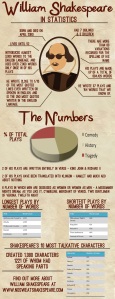
Teaching Point of View
Mary has shared a point of view project she likes to do with her class. She found a number of pictures online that she pasted in the middle of poster board. She then sectioned off the poster into 5 labeled parts; one for each point of view plus a section for “perspectives” for students understand how perspective is different than point of view. The posters are then placed around the room. Students are then divided up and start by filling out the “perspective” section of their poster (pointing out everyone who might have a perspective in the image and a short summary of what they may be thinking). Students then rotate to a new picture and write a narrative in the first person point of view using one of the perspective the previous group wrote (in the “First Person” section). This process is repeated until the poster is filled. The finished posters can then be hung up as reminders of what students learned. To see Mary’s instructions as well as other activities she did to teach her students about point of view, click here!
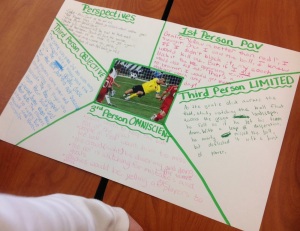
Want to Kick it Up a Notch?
For older students, this same project can be used to integrate the concept of perspective with a class reading. For our purposes, we will assume that one square (perspectives) is a constant; students refer to it in all of the other squares. When using this with a reading, the constant can be characters in the story and the other squares could be important events from the text. Students can then write a reaction/opinion/analysis of each event from the perspective of one of the listed characters. This same activity can also work in reverse, with the constant being one particular event and the other squares different characters. The image in the center can be related to the characters/events or can be eliminated completely. For an additional challenge, the teacher can let e student(s) decide which events and/or characters should be used.
This activity can also be slightly simplified. Like Marie, you can choose pictures you would like to use and place them on poster board. Decide how many rotations you would like students to accomplish and section off the board according to that number. Each rotation, students would identify a perspective, label one of the segments, and then write a narrative about the event being depicted from the perspective they have identified.
Making Words Plural
Marie Rippel created this graphic to help teach students how to make different words plural. Each of the six rules of pluralization has its own ‘scoop’ on the ice cream cone. Marie encourages teachers to focus on one scoop at a time, adding scoops each lesson until you reach the whipped cream on top. This graphic can be used as a teaching tool, a poster, or as a notecard for students. To see more resources like this one, visit the “All About Learning Website”.

Poetic Devices Minibook
Jimmie Lanley has created a collection of cards in order to teach students about the different devices authors and poets use. Each colorful card provides a device’s name, its definition and a blank square for students to write an example. These can be used as individual cards that can be placed on key rings or as posters to be hung around the room. For the link to this resource and more by Jimmie Lanley, click here.

Want to Kick it Up a Notch?
Instead of using these cards to practice examples of these devices, students can also use these to identify examples in an assigned text. This can be done individually using cards or in groups as a jigsaw activity. If you laminate the cards/posters beforehand and use dry-erase markers or sticky notes, you can reuse the cards/posters multiple times for different assignments.
Anchor Charts
Gay Miller has shared a collection of anchor charts she has created in order to teach English. These charts cover a wide variety of concepts and each one comes with an article about the chart and how Gay used it. To see the charts and more resources from Gay, click here!
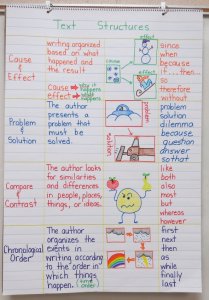
5 Mini-Lessons That Teach Theme
Samantha Cleaver has provided five ideas for short lessons you can quickly and easily integrate into your classroom. They recommend specific sources for each lesson, but these can easily be swapped out to better meet your classroom needs. The original post where you can find these lessons also has tips for teaching about theme. Most of these tips are already practiced by trained teachers however, they can make an excellent handout for English teachers to provide parents in order to describe what kind of support they can provide their students at home. To see the full article, click here.

5 Ways to Use Memes in Class
Tracee Orman has taken the ever popular meme and found ways to use them in the classroom. Memes can make classroom content engaging and/or help make you and your curriculum relevant to students. Tracee describes 5 different ways memes can be used and provides examples of each. She also provides links where you can download pre-made Meme templates and Meme posters however, these are not free. To read more about how to use memes in your classroom, click here. ((Disclaimer: FUTD is not associated with Tracee Orman and does not benefit from the sale of Tracee Orman’s products in any way))
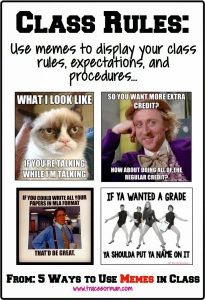
Homophone Word Wall
Nyla has created a set of homophone cards that can be used in the classroom. Each card contains a homophone pair and an accompanying image for each word.. There are many cards included in this sheet that can be used to create a word wall and/or for class activities. The printout Nyla has created is available for download however, it is not for free. For more information about Nyla’s cards and for links to the download pages, click here.
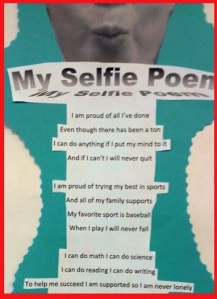
My Selfie Poem
In celebration of poetry month, Gina Kennedy has developed an activity using selfies. Students take selfies and print out their pictures. They then create a poem describing what they are most proud of about themselves and their accomplishments from the year. They then paste their selfie and poem on colored paper/poster paper and hang them around the room. Gina also provides a number of other English activities students can do to learn and practice poetry. To read about this project and see more from Gina, click here.
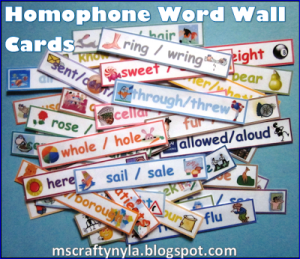
Want to Kick it Up a Notch?
Where Gina uses this activity as a reflective assignment, it can also be a great introductory assignment as well. It could be what students are proud about but also about what they most look forward to/their goals for the year. Even if students have not practiced poetry yet, it would provide a baseline and is an excellent way to get to know your students.
To really change things up, have students write a similar poem for a character in a reading they are doing. The poem can be the character reflecting on a specific event or looking back on how they have changed throughout the story.

